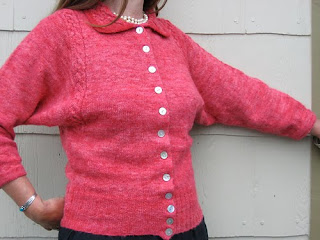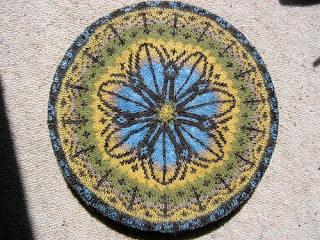The Oamaru Textile Exchange has been selling buttons from the collection of an American who recently moved here. Every Tuesday she brings in some more and I try to find an excuse to go to town and have a look at them. Of course, many of them are quite expensive, so mostly I just look but I have bought a few. This tam uses one of them for its design - an old Czech glass button with some nice bits of inlaid cut glass. It has a nine point star so the tam is bigger than usual to show it off. The button you can see securely (I hope) sewn in the centre.
The thistles are there because they're flowering everywhere I look and when I remove them my fingers get full of prickles and I end up knitting with the prickles still in place.
Saturday, February 20, 2010
Sunday, February 14, 2010
Batwing Cardigan
A couple of years ago I bought a very dirty white cria fleece for $20 and it’s been waiting to be used since then. I decided that a light weight cardigan would be most useful in this climate, so I spun it as finely as I could and asked Doespins if she would dye it for me. It came out a beautiful raspberry pink.
The pattern uses a wool called May Queen but I don’t know what it was exactly. The design seems to be early 1950s and the needle size is quite small. I imagine May Queen was a fine 2-ply. I had to go down a needle size to get the correct tension.
The buttons were a problem and I never quite solved it. I wanted vintage shank buttons in pearl or diamante but finding twelve to match was too difficult and in the end I just used what I had.
I particularly like the little cabled collar.
The pattern uses a wool called May Queen but I don’t know what it was exactly. The design seems to be early 1950s and the needle size is quite small. I imagine May Queen was a fine 2-ply. I had to go down a needle size to get the correct tension.
The buttons were a problem and I never quite solved it. I wanted vintage shank buttons in pearl or diamante but finding twelve to match was too difficult and in the end I just used what I had.
I particularly like the little cabled collar.
Joe's Socks
Because we lost our cow to milk fever, I’ve been hand rearing the calf. The milk powder costs a lot - more than $80 a bag - and he drinks a lot. Before Christmas our neighbour stopped in to visit while I was feeding the calf and asked me what I wanted for Christmas. I jokingly said a bag of milk powder. You can guess what happened. These socks are a small repayment for his generosity. And the calf is looking fat and happy.
The wool is from a fleece the same neighbour gave me last year. It’s Romney from a dry ewe, so it was quite lustrous and should be strong.
The dyes are two shades of madder, poroporo and brazilwood overdyed with indigo.
The wool is from a fleece the same neighbour gave me last year. It’s Romney from a dry ewe, so it was quite lustrous and should be strong.
The dyes are two shades of madder, poroporo and brazilwood overdyed with indigo.
Finlandia Tam
I’ve been listening to a lot of Sibelius lately and I also just read Tove Jansson’s The Summer Book where she describes summers spent on an island in the Gulf of Finland. This tam is meant to try to capture some of the feel of the book and the music. It’s got anchors and pine trees and waves and I hope the colours are right. I’ve never been to Finland.
I used indigo, safflower, poroporo and a natural beige and black for the colours.
I used indigo, safflower, poroporo and a natural beige and black for the colours.
Logwood Tam
This is an experiment with the colour contrasts from the logwood dye. It gives a good background to the reds and pinks, as you would expect, but for the central wheel I replaced it as the main colour with the natural black to give more definition to the pattern.
The dyes I used are logwood, madder and red sandalwood, so it was a restrained selection.
I’ve been a bit slow with the tams lately but we’ll be shearing the sheep tomorrow and there’ll be lots of fresh wool to work with.
The dyes I used are logwood, madder and red sandalwood, so it was a restrained selection.
I’ve been a bit slow with the tams lately but we’ll be shearing the sheep tomorrow and there’ll be lots of fresh wool to work with.
Woods in Winter Tam
This tam took a while to complete because of the cow going down with milk fever and needing constant care. It uses just primary colours and traditional dyes, madder, safflower, indigo and logwood. It was my first time dyeing with logwood and I was impressed by its colour and the quantity of dye from a small amount of powdered wood.
The centre wheel is an asymmetrical design of leafless trees.
The centre wheel is an asymmetrical design of leafless trees.
Woodcutter's Socks
These socks are for a friend who is helping to cut trees in the woodlot. They’re made from handspun Romney which I’ve found to be very hard wearing for work socks. He’s cutting eucalyptus trees so the main colour - the orange - is dyed with eucalyptus leaves. The green is poroporo, a pioneer species which is growing in the woodlot. The other colours are from madder and onion skins.
Please note, this is not a self striping yarn, but a controlled mix of colours.
Please note, this is not a self striping yarn, but a controlled mix of colours.
Shawl Collared jacket
 This jacket is made from an old jumper that I knitted in alpaca about 15 years ago. The jumper had grown a lot more than I have and even with the sleeves rolled back several times I couldn’t wear it comfortably so I unpicked and unravelled it. It was hard going because the pattern was very complex and it was upsetting to undo all that work.
This jacket is made from an old jumper that I knitted in alpaca about 15 years ago. The jumper had grown a lot more than I have and even with the sleeves rolled back several times I couldn’t wear it comfortably so I unpicked and unravelled it. It was hard going because the pattern was very complex and it was upsetting to undo all that work. The original jumper was white but had got some stains on it so I dyed the alpaca with safflower and then with logwood. I found some of the leftover white wool and some red and added a couple of slipstitch patterns to the original stocking stitch design to disguise any unevenness in the dyeing.
The slipstitch patterns are from Barbara Walker’s Treasury of Knitting Patterns. The red and white is Stripe and Spot pattern and the one on the body is called Little Birds.
The finished jacket is very warm and comfortable to wear and has stayed the right size so far.
The pattern can be found in Christina Probert’s Knitting in Vogue. It dates from 1961.


Subscribe to:
Comments (Atom)
























